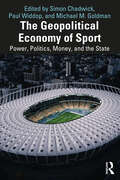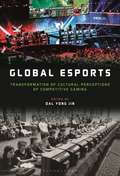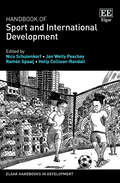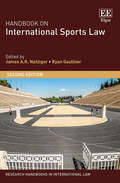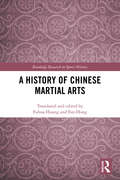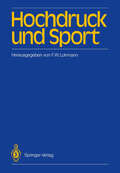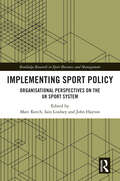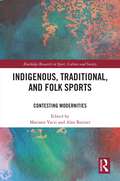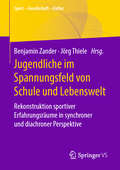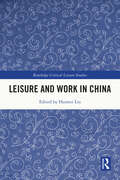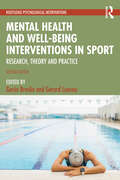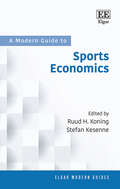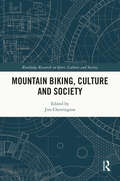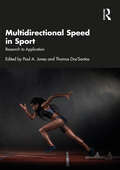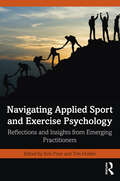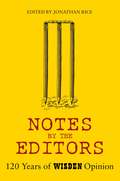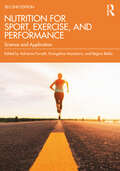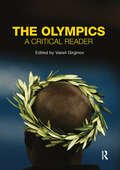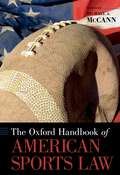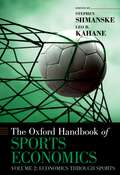- Table View
- List View
The Geopolitical Economy of Sport: Power, Politics, Money, and the State
This is the first book to define and explore the geopolitical economy of sport – the intersection of power, politics, money, and state interests that both exploit and shape elite sport around the world. Russia’s invasion of Ukraine, the global response, and the consequent ramifications for sport have put the geopolitical economy of sport front and centre in both public debate and academic thinking. Similarly, the Winter Olympics in Beijing and the FIFA World Cup in Qatar illustrate the political, economic, and geographic imperatives that shape modern sport. This book brings together studies from around the world to describe this new geopolitical economy of sport, from the way in which countries use natural resource revenues, accusations of sport washing, and the deployment of sport for soft power purposes, to the way in which sport has become a focus for industrial development. This book looks at the geopolitical economy of sport across the globe, from the Gulf States’ interests in European soccer to Israel seeking to build a national competitive advantage by positioning itself as a global sports tech start-up hub, and the United States continuing to extend its economic and cultural influence through geopolitical sport activities in Africa, Latin America, and the Indian subcontinent. This book captures a pivotal moment in the history of sport and sport business. This is essential reading for any student, researcher, practitioner, or policymaker with an interest in sport business, the politics of sport, geopolitics, soft power, diplomacy, international relations, or international political economy.
Global esports: Transformation of Cultural Perceptions of Competitive Gaming
Global eSports explores the recent surge of eSports in the global scene and comprehensively discusses people's understanding of this spectacle. By historicizing and institutionalizing eSports, the contributors analyze the rapid growth of eSports and its implications in culture and digital economy. Dal Yong Jin curates a discussion as to why eSports has become a global phenomenon. From games such as Spacewar to Starcraft to Overwatch, a key theme, distinguishing this collection from others, is a potential shift of eSports from online to mobile gaming. The book addresses why many global game players and fans play and enjoy online and mobile games in professional game competitions, and therefore, they investigate the manner in which the transfer to, from and between online and mobile gaming culture is occurring in a specific subset of global youth. The remaining focus identifies the major platforms used to enjoy eSports, including broadcasting and smartphones. By analyzing these unexamined or less-discussed agendas, this book sheds light on the current debates on the growth of global eSports culture.
Handbook of Sport and International Development (Elgar Handbooks in Development)
With sport’s role now firmly embedded in international development contexts, policy and delivery, this comprehensive Handbook provides a contemporary, multi-disciplinary overview of state-of-the-art research in this critical space. It features a holistic synthesis of current scholarship as well as new and emerging approaches, contexts and development foci. The Handbook includes chapters on a great variety of sport initiatives, ranging from small community projects to large-scale international events. The Handbook establishes the nexus between reflection, action, and innovation by presenting critical issues from diverse perspectives and with varied voices. Contributors include seminal scholars from broader disciplines, sport-specific development experts as well as up-and-coming academics who address contemporary challenges such as climate change, gender discrimination, athlete diplomacy and the effects of – and sports’ responses to – the COVID-19 pandemic. Overall, the Handbook offers critical outlooks regarding concepts, methodologies, collaborations and knowledge mobilisation in sport and international development. The Handbook of Sport and International Development will be a crucial resource for those studying and researching sport in international development settings. It will also be critical for policymakers and development practitioners seeking to gain a broader perspective on the important role of sport in international development.
Handbook on International Sports Law (Research Handbooks in International Law series)
The second edition of this comprehensive Handbook presents new and significantly revised chapters by leading scholars and practitioners in the burgeoning field of international sports law. National, regional and comparative dimensions of sports law are emphasized throughout, exploring a wide range of issues emerging in sports law today. Approaching international sports law through three converging frameworks, this Handbook examines the institutions of international sport, the eligibility rights and protections of athletes, as well as the commercial side of international sport. New topics discussed in this edition include concussions, EU antitrust and other regulation of sport, review of awards by the Court of Arbitration for Sport (CAS), college and university athletics, league and team restrictions on athlete movement, taxation of athletes and sports as cultural heritage. Covering some of the most controversial and cutting-edge issues in international sports law, this timely Handbook will prove invaluable for academics and students of sports law, sports management, international law and comparative law. With a global scope, the Handbook will also prove a vital resource to practicing lawyers, players’ agents, senior executives and other professionals within the sports industry.
A History of Chinese Martial Arts (Routledge Research in Sports History)
Chinese martial arts have a long, meaningful history and deep cultural roots. They blend the physical components of combat with strategy, philosophy and tradition, distinguishing them from Western sports. A History of Chinese Martial Arts is the most authoritative study ever written on this topic, featuring contributions from leading Chinese scholars and practitioners. The book provides a comprehensive overview of all types of Chinese martial arts, from the Pre-Qin Period (before 222 BC) right up to the present day in the People’s Republic of China, with each chapter covering a different period in Chinese history. Including numerous illustrations of artefacts, weaponry and historical drawings and documents, this book offers unparalleled insight into the origins, development and contemporary significance of martial arts in China. This is a fascinating read for researchers and students working in sports history, Chinese sport and Chinese Studies.
Hochdruck und Sport
Die arterielle Hypertonie ist einer der haufigsten Risikofaktoren fUr die in unserer Gesellschaft dominierenden kardiovaskularen Erkrankungen und Todesfalle. 1m Zusammenhang mit der Betreuung von Hypertonie-Patienten wird immer wieder die Frage gestellt, in welcher Weise und in welchem MaBe sich der Patient mit arte rieller Hypertonie korperlich betatigen darf und sollte. Insbesondere beziehen sich in diesem Zusammenhang die Fragen immer wieder auf das Problem "Hochdruck und Sport". Das AusmaB des Blutdruckanstiegs bei korperlicher Leistung ist nun davon ab hangig, ob es sich urn eine dynamische (Laufen) oder aber urn eine isometrische (Kraftsport) Belastung handelt; bei der letzteren Belastungsart erfolgt namlich ein deutlich starkerer Blutdruckanstieg als bei dynamischem Bewegungssport. Der Hy pertonie-Patient reagiert nun auf jedwede korperliche Belastung mit einem starke ren Blutdruckanstieg als der Normotoniker, was grundsatzlich eine gesteigerte Be lastung und damit ein erhohtes Risiko fUr Herz und GefaBsystem bedeutet. Daher sollten Hypertonie-Patienten zweckmaBigerweise nur dynamischen Be wegungssport durchfUhren, der dariiberhinaus im Einzelfall den Bluthochdruck selbst gunstig beeinflussen kann. Andererseits sollte nicht davon ausgegangen wer den, daB z. B. Ausdauertraining ein Ersatz fUr eine notwendige antihypertensive Pharmakotherapie darstellt. Bei der medikamentosen Hochdrucktherapie sind si cherlich diejenigen Pharmaka in der Mono-und Kombinationstherapie besonders geeignet, die den Blutdruck nicht nur unter Ruhebedingungen sondern auch gerade bei Belastung senken bzw. normalisieren. Dabei stellt sich jedoch zwangslaufig die Frage, wie die korperliche Leistungsfahigkeit durch Antihypertensiva beeinfluBt wird.
Implementing Sport Policy: Organisational Perspectives on the UK Sport System (Routledge Research in Sport Business and Management)
This book critically examines the roles and contributions of different organisations in the implementation of sport policy in the UK, and therefore provides an important guide to the complexities of implementing sport policy and of achieving policy goals through, and for, sport. Presenting analytical chapters by leading sport researchers alongside shorter commentaries by practitioners working in the field, the book outlines the uneven path between policy planning and real-world outcomes. Adopting a multi-level analysis, it examines the interlocking structures and challenges of organisations from grassroots voluntary sport to national governing bodies and professional clubs, and considers the most important issues affecting UK sport policy today. This is fascinating reading for any student, researcher or practitioner working in sport policy, sport for development, sport management, sport coaching, physical education, and related areas of policy such as public health, community development, social policy, public policy and education.
Indigenous, Traditional, and Folk Sports: Contesting Modernities (Routledge Research in Sport, Culture and Society)
This is the first book to focus on indigenous, traditional, and folk sports and sporting cultures. It examines the significance of sporting cultures that have survived the emergence and diffusion of western sports and have carved out a unique position not only in spite of modernity but also in response to it. Presenting case studies from around the world, including from Europe, Asia, Africa, and the Americas, this book draws on multidisciplinary work from sociology, anthropology, history, cultural studies, and political science, exploring key themes in the social sciences including nationalism, identity, decolonisation, and gender. From Turkish oil wrestling, kabaddi in South Asia, Iroquois lacrosse, to wushu and sumo in East Asia and various European traditional sports, these sporting practices continue to capture the indigenous imagination on the margins of the western hegemonic sport complex. Situated in the fissures between the local, the national, and the global; between the archaic and the modern; and between ritual and record, they inhabit a liminal space of transformation as they assume new cultural and political meanings, offering important perspectives on the complexities and contradictions of modernity. The volume’s decolonial perspective lies in its promotion of indigenous and subaltern worldviews through their traditional movement cultures on the margins of the western hegemonic sport complex. This is a fascinating reading for anybody with an interest in sport, nationalism, Indigenous studies, heritage and folklore studies, anthropology, social and cultural history, or globalisation.
Jugendliche im Spannungsfeld von Schule und Lebenswelt: Rekonstruktion sportiver Erfahrungsräume in synchroner und diachroner Perspektive (Sport – Gesellschaft – Kultur)
Schulsportforschung und Jugendsportforschung stehen noch häufig unverbunden nebeneinander. Dieses Defizit versucht die vorliegende Studie zu bearbeiten, indem sie sportive Orientierungen von Jugendlichen in den Kontexten von Schule und Freizeit rekonstruiert. Befragt wurden Jugendliche im Rahmen von längsschnittlich angelegten Gruppendiskussionen im 7. und 9. Schuljahr. Um die Frage nach der Passung von schulischen und lebensweltlichen Kontexten möglichst kontrastreich erfassen zu können, wurden die Gruppen bewusst nach unterschiedlichen sozialstrukturellen Merkmalen ausgewählt. Im Ergebnisteil werden die weitgehend auf Grundlage der dokumentarischen Methode ausgewerteten Gruppendiskussionen einerseits in synchroner Perspektive nach thematischen Schwerpunkten geordnet vorgestellt (Erfahrungsraum Schule, Erfahrungsraum Sportunterricht, Erfahrungsraum Freizeit) und andererseits in diachroner Perspektive identifizierte Wandlungen dieser Erfahrungsräume vom 7. zum 9. Schuljahr in den Blick genommen.
Leisure and Work in China (Routledge Critical Leisure Studies)
This is the first book to explore the meaning and significance of leisure in Chinese society, as well as the relationship between leisure and work that reveals so much about a society’s cultural values.Exploring philosophical and theoretical concepts from a Chinese perspective, the book also presents a series of cutting-edge case studies of leisure and work life that add a new dimension to our understanding of contemporary China. Featuring the work of leading Chinese researchers, the book examines key concepts and theories in contemporary leisure studies, including workleisure relationships, free time, freedom, labour alienation, leisure alienation, the impact of technology on leisure and work, and subjective well-being and health. It also presents an important snapshot of life in contemporary China – and contemporary Leisure Studies in China – at a moment in which China’s society and economy are adjusting to a new post-COVID reality.This book is fascinating reading for anybody with an interest in leisure studies, sociology, Asian studies, and cultural studies.
Mental Health and Well-being Interventions in Sport: Research, Theory and Practice (Routledge Psychological Interventions)
Now in its second edition, this book provides a focused, comprehensive overview of up-to-date mental health research, models, and approaches in sport, with expertise from global experts in the field.Mental health remains a widely growing area in the field of sport psychology, which requires expert guidance and care in promoting effective well-being for athletes, coaches and sport officials. Fully updated throughout, Mental Health and Well-being Interventions in Sport is an indispensable guide for researchers, practitioners and students wanting to understand and implement sport-based intervention processes. This important book adopts an evidenced based approach, discussing the context of the intervention, its design and implementation, and its evaluation and legacy. Exploring areas such as injury, rehabilitation, depression, eating disorders, verbal and physical abuse, and athletic burnout, this insightful volume dissects emerging research into straightforward accessible chapters. Offering a cutting-edge overview of the key issues involved in this burgeoning area, as well as example cases of how sport has been used in extreme environments such as prisons as a method to improve mental health, the book will benefit practitioners, policy makers and researchers.Written for newcomers and established practitioners across a variety of sports setting and contexts, the authors highlight the need for "another call to action" to support the mental health and wellbeing of all involved in sport. Presenting current research, theory and practice in the field, the text is an essential read for researchers, practitioners, and coaches to better understand sport-based intervention processes.
A Modern Guide to Sports Economics (Elgar Modern Guides)
This timely Modern Guide offers critical insights into developments in both professional and recreational sports through the lens of the economic forces that determine them. It explores the benefits of the relationship between sports and economics, highlighting ways that economic research can help to understand sports better and the ways that sport provides opportunities to test economic theories. With both theoretical and empirical chapters, the book looks at the development of European sports economics over the last 20 years, the relationship between competitive balance and attendance, and the potential economic impact of sports events. Chapters further examine specific issues in sports from an economic perspective, including labour market restrictions on professional leagues, refereeing, team dynamics, the importance of good players versus good results and the sports analytics revolution due to big data. The use of state-of-the-art empirical methods makes this Modern Guide a crucial read for economists and sports science researchers looking to better understand both the relationship between the two fields and their own area of research. Sports policy makers will also appreciate the in-depth discussion on a range of different recreational and professional sports.
The Mountain and the Politics of Representation (Liverpool Studies in the Politics of Popular Culture)
The stories we tell, published or otherwise, condition our mountain experiences in practice and reinforce cultural memory and representation. Yet, as this book and the authors within it set out to demonstrate, if we look beyond the boundaries of this ‘singular white history’ there is a rich diversity of stories to tell. This volume contributes to a growing body of scholarship that calls for a heterogeneity of voices in mountain memoir genres. For the first time, this diverse scholarship interrogates how mountaineering literary and media culture impact bodies, spaces, and places, in order to nuance how commodification intersects across social categories and is embodied in multi-dimensional ways. In this volume, we explore a burgeoning tradition of mountaineering literature, of cinema and of memoir to appreciate difference, beyond the habitual heroic, white male, adventurer that dominates screens and bookshelves. Through exploring multidimensional axes of social differentiation from gender, race, class, and age to dis/ability and sexuality, the book will demonstrate how commodification is embodied through representation in mountaineering literature, media, film and memoir in mountaineering spaces. Amongst our aims, this book intends to understand how multiple social dimensions overlap and work to produce independent systems of exclusion and inclusion that focus on untraditional ways to be a mountaineer.
Mountain Biking, Culture and Society (Routledge Research in Sport, Culture and Society)
This book represents the first critical examination of the social, cultural, and political significance of mountain biking in contemporary societies. Starting from the premise that cultures of mountain biking are diverse, complex, and at times contradictory, the book offers practical and theoretical insights into a range of embodied, material, and socio-technical relationships. Featuring contributions from an interdisciplinary team of researchers, artists, and (Indigenous) community members with backgrounds in sociology, anthropology, cultural studies, community development, and coaching, chapters critically unpack the complex and contested nature of mountain biking identities, bodies, environments, and inequalities within specific settings. Via a range of international case studies from England, Scotland, America, Canada, New Zealand, and South Africa, authors highlight how tensions and conflicts in the world of mountain biking initiate important conversations about climate change, colonialism, discrimination, and land-use. This is essential reading for academics and practitioners in sociology, cultural studies, sport-for-development, and human geography.
Multidirectional Speed in Sport: Research to Application
During field- and court-based sports, players are continually required to perceive their environment within a match and select and perform the most appropriate action to achieve their immediate goal within that match instance. This ability is commonly known as agility, considered a vital quality in such sports and may incorporate a variety of locomotion and instantaneous actions. Multidirectional speed is a global term to describe the competency and capacity to perform such actions: accelerate, decelerate, change direction, and ultimately maintain speed in multiple directions and movements within the context of sports-specific scenarios, encompassing agility, speed, and many other related qualities. Multidirectional speed in sport depends on a multitude of factors, including perceptual-cognitive abilities, physical qualities, and the technical ability to perform the previously mentioned actions. Multidirectional Speed in Sport: Research to Application reviews the science of multidirectional speed and translates this information into real-world application in order to provide a resource for practitioners to develop multidirectional speed with athletes, bringing together knowledge from a wealth of world-leading researchers and applied practitioners in the area of speed and agility to provide a complete resource to assist practitioners in designing effective multidirectional speed development programmes. This text is critical reading for undergraduate and graduate sports science students, all individuals involved in training athletes (e.g. coaches, physiotherapists, athletic trainers), and researchers in the field of sports science and sports medicine.
Navigating Applied Sport and Exercise Psychology: Reflections and Insights from Emerging Practitioners
In recent years, more students have chosen to study sport and exercise psychology with a view to building careers as applied practitioners. While sport and exercise psychology master’s graduates leave university with the necessary theoretical knowledge to inform their practice, they are often left wanting to know more about creating and navigating a career within the field.Navigating Applied Sport and Exercise Psychology provides readers with an honest and contemporary insight into the work and experiences of trainees and early career practitioners. This book delves further into the more complex and nuanced experiences of being an applied practitioner. Using case studies and reflections, the chapters explore key topics including working within multi-disciplinary teams, maintaining ethics and integral practice during challenging conversations and supporting mental health in high-performance environments. Written by trainees and early career practitioners, this book is vital reading for students, early career practitioners, and anyone interested in sport psychology.Erin Prior is a BPS Chartered, HCPC registered Sport and Exercise Psychologist. As an applied practitioner, Erin works with a range of individuals, teams, and organisations across various sports. Alongside her applied practice, Erin is completing her PhD which is focused on athlete mental health, at Loughborough University.Tim Holder, PhD, is an HCPC Registered Sport and Exercise Psychologist, BPS Chartered and a BASES Fellow. He is an applied sport psychology consultant and supervisor to students working towards practitioner status in the UK. Tim is the Programme Leader for the MSc in Applied Sport Psychology at the University of Winchester, UK.
Notes By The Editors: 120 Years of Wisden Opinion
'The Editor of Wisden is an important personage. It is he who decides the policy of the Cricketers' Bible and cricketers the world over look to him to give a lead on all controversial problems. His is, therefore, no easy task, but Wisden has been fortunate in its editors'. That was written in 1933, and it is still true. The heart of the Almanack is the section entitled Notes By The Editor. The editor's opinions can change careers, laws – indeed every part of the game. This anthology is a brief dip into the half a million words or so that make up the annual Notes as the editors take a view of what really matters – the spirit in which cricket is played and how to keep it relevant and popular. And, of course, the weather. Throughout the Notes the Editors retain their sense of optimism and fervent love of the game, even when dealing with difficult issues such as bodyline or match-fixing, and they express their views succinctly and stylishly. As John Woodcock wrote in 1983, 'the game is never quite the same from one season to the next' and nor, indeed, are the Notes. However, as this anthology shows, the Notes are always stimulating and firmly expressed, providing an important insight into the cricket of the day.
Nutrition for Sport, Exercise, and Performance: Science and Application
Nutrition for Sport, Exercise, and Performance offers a clear, practical, and accessible guide to building a comprehensive understanding of sport and exercise nutrition from leading experts in nutrition and exercise science. Nutrition before, during, and after training or a sporting event can improve the comfort, energy, and performance of athletes of all levels, from elite to recreational, as well as providing long-term health benefits. As such, nutrition is a key element of an athlete’s health and performance strategy, whether competing recreationally or at an elite level.Split into three parts, this new and revised edition of Nutrition for Sport, Exercise, and Performance provides an evidence-based introduction to nutrition for sport, exercise, and performance. Part I focusses on nutrition and sport science by explaining key principles underpinning sports nutrition science, including energy systems, exercise physiology and metabolism, and the digestion and absorption of macronutrients and micronutrients essential for performance and discusses factors influencing dietary intake, energy availability, and the process of dietary assessment. Part II is focussed on nutrition for exercise, pre- and post-training, hydration, supplements, and body composition measurement and modification. The final part (Part III) focusses on applied sports nutrition for a range of sports and athletes. This second edition delivers new insights into working with female athletes, occupational athletes, and athletes in contemporary sports including sport climbing, surfing, skateboarding, and breaking.Featuring contributions from a range of sport and exercise nutrition professionals with practical sports nutrition strategies and the latest evidence and practice guidelines, this is a core reference for undergraduate students, sports professionals, and aspiring athletes alike.
The Olympics: A Critical Reader
The Olympics: A Critical Reader represents a unique, critical guide to the definitive sporting mega-event and the wider phenomenon it represents – Olympism. Combining classic texts and thoughtful editorial discussion with challenging new pieces, including previously unseen material, the book systematically addresses the key questions in modern Olympism, including:what does studying Olympism entail?how do historical accounts create and challenge Olympic myths?how do different theoretical perspectives inform our understanding of Olympism?which socio-political processes influence personal, collective and imagined Olympic identities?how do we experience and make sense of Olympism?who owns Olympism and why does it matter?how do cities compete for and celebrate the Olympics?How are the Olympic values promoted?why is it important to protect the ethical principles and properties of Olympism?what are the grounds for contesting Olympism?how can Olympism be taught?how can the principles and practices of Olympism be sustained in the future?Each thematic part has been designed to include a range of views, including background treatment of an issue as well as critical scholarship, to ensure that students develop a well-rounded understanding of the Olympic phenomenon. The Olympics: A Critical Reader is essential reading for students of the Olympics and Olympism, the sociology of sport, sport management and cultural studies.
The Oxford Handbook of American Sports Law (Oxford Handbooks)
The Oxford Handbook of American Sports Law takes the reader through the most important controversies and critical developments in law and U.S. sports. Over the course of 30 chapters, leading scholars explore this expanding and captivating area of law. The Handbook is the first book to gather dozens of perspectives on sports law controversies in the United States, and will be of interest to those who study and practice sports law, as well as journalists, broadcasters, and legally minded sports fans. The Oxford Handbook of American Sports Law incorporates analysis of key historical events in sports law-such as the rise of free agency in professional sports and the concept of "amateurism" for college athletes-and their broader context. Contemporary legal controversies in U.S. sports and their accompanying questions are also of central importance: In a sensible legal system, how would long-term neurological injuries from contact sports be addressed? How would the use of racially insensitive team names be resolved? How would a seemingly trivial dispute over air pressure in footballs be studied from the competing perspectives of players, teams, and leagues? The Oxford Handbook of American Sports Law weighs not just the facts, but how courts and lawmakers ought to consider the most important questions at stake. The essays in this volume also canvass the types of legal controversies in sports likely to surface in the future. This is particularly true of law and technology matters, including those related to broadcasting and streaming. Legal doctrine has been and will continue to be forced to adapt to these developments, and the Handbook both forecasts coming debates and outlines where the law may be headed.
The Oxford Handbook of Sports Economics: Volume 2: Economics Through Sports (Oxford Handbooks)
Shmanske and Kahane have brought together nearly all of the important authors in the quickly growing field of Sports Economics to contribute chapters to this two-volume set. All of the authors are writing about subjects that they love and subjects that they have devoted years of study to. The result is truly informative in its content and path breaking in its importance to the field. Anyone contemplating research in the field of sports economics will find the works in these volumes to provide both ample background in subject after subject and numerous suggestions for future avenues of research. The editors have recognized two ways that economics and sports interact. First, economic analysis has helped everyone understand many of the peculiar institutions in sports. And second, quality data about individual productivity, salaries, career histories, teamwork, and managerial behavior has helped economists study topics as varied as the economics of discrimination, salary dispersion, and antitrust policy. These two themes of economics helping sports and sports helping economics provide the organizational structure to the two-volume set. The reader will find that sports economists employ or comment on practically every field in economics. Labor Economics comes into play in the areas of salary formation, salary dispersion, and discrimination. Baseball's history and the NCAA are studied with Industrial Organization and Antitrust. Public Finance and Contingent Value Modeling come into play in the study of stadium finance and franchise location. The Efficient Market Hypothesis is examined with data from gambling markets. Macroeconomic effects are studied with data from mega events like the Super Bowl, The World Cup, and the Olympics. The limits of Econometrics are pushed and illustrated with superb data in many of the papers herein. Topics in Applied microeconomics like demand estimation and price discrimination are also covered in several of the included papers. Game Theory, measurement of production functions, and measurement of managerial efficiency all come into play. Talented authors in each of these fields have made contributions to these volumes. The volumes are also rich from the point of view of the sports fan. Every major team sport is covered, and many interesting comparisons can be made especially between the North American League organization and the European-style promotion and relegation leagues. Golf, NASCAR, College athletics, Women's sports, the Olympics, and even bowling are represented in these pages. There is literally something for everyone.
Paralympic 5-a-side football (Large Print)
This page has three images on it: a player trying to stop an opponent passing the ball, two players trying to gain possession of the ball, and a diagram showing the layout of a 5-a-side pitch. All players have sight problems and wear blindfolds. The ball makes a noise to help players locate it and sighted goalkeepers are allowed to shout instructions to players. Each image has a dashed line image border. There is a locator dot shown, which will be at the top left of the page when the image is the correct way up. Player trying to stop an opponent passing the ball. - The image on the top left of the page shows two players and a football. The player to the left is facing to the right, his face in profile and his body twisted so it is facing you. He has his arms extended out to the left and right. One leg is going down the page and left, the other is reaching out to the right and almost touching the ball further right. On the right of the image, an opposing player is facing left with his face in profile and his body turned to face you. His arms reach out to the left and right. He has his foot to the right lifted up, ready to kick the ball and pass it to a teammate.Two players trying to gain possession of the ball - This image, at the bottom left of the page, shows two players and a football. On the left of the image, a player is seen from the side facing right. He has his arms stretched out to the left and right and he is supported on one leg, while his other leg extends out to the right trying to make contact with the ball above. The opposing player on the right of the image is facing left and seen from the side. With his arms stretched out to the left and right, he is running towards the other player to tackle him and try to take possession of the ball.Diagram of a 5-a-side football pitc: This diagram is on the right of the page. The two teams are represented by large dots and crosses. At the top of the image is a goal shown as a small rectangle. Down the page from this is the penalty area and penalty spot. Going across horizontally in the centre of the image, is the halfway line, with the centre spot and centre circle in the middle. The layout in the top of the diagram is mirrored in the bottom. The playing area is 140 feet x 85 feet. The two teams, dots and crosses, have adopted different playing positions. Apart from the last man's in defence near the goal, many teams do not have fixed roles for players. This allows a more fluid game with players reacting to the game as it progresses.
Paralympic 5-a-side football (UEB Contracted)
This page has three images on it: a player trying to stop an opponent passing the ball, two players trying to gain possession of the ball, and a diagram showing the layout of a 5-a-side pitch. All players have sight problems and wear blindfolds. The ball makes a noise to help players locate it and sighted goalkeepers are allowed to shout instructions to players. Each image has a dashed line image border. There is a locator dot shown, which will be at the top left of the page when the image is the correct way up. Player trying to stop an opponent passing the ball. - The image on the top left of the page shows two players and a football. The player to the left is facing to the right, his face in profile and his body twisted so it is facing you. He has his arms extended out to the left and right. One leg is going down the page and left, the other is reaching out to the right and almost touching the ball further right. On the right of the image, an opposing player is facing left with his face in profile and his body turned to face you. His arms reach out to the left and right. He has his foot to the right lifted up, ready to kick the ball and pass it to a teammate.Two players trying to gain possession of the ball - This image, at the bottom left of the page, shows two players and a football. On the left of the image, a player is seen from the side facing right. He has his arms stretched out to the left and right and he is supported on one leg, while his other leg extends out to the right trying to make contact with the ball above. The opposing player on the right of the image is facing left and seen from the side. With his arms stretched out to the left and right, he is running towards the other player to tackle him and try to take possession of the ball.Diagram of a 5-a-side football pitc: This diagram is on the right of the page. The two teams are represented by large dots and crosses. At the top of the image is a goal shown as a small rectangle. Down the page from this is the penalty area and penalty spot. Going across horizontally in the centre of the image, is the halfway line, with the centre spot and centre circle in the middle. The layout in the top of the diagram is mirrored in the bottom. The playing area is 140 feet x 85 feet. The two teams, dots and crosses, have adopted different playing positions. Apart from the last man's in defence near the goal, many teams do not have fixed roles for players. This allows a more fluid game with players reacting to the game as it progresses.
Paralympic 5-a-side football (UEB Uncontracted)
This page has three images on it: a player trying to stop an opponent passing the ball, two players trying to gain possession of the ball, and a diagram showing the layout of a 5-a-side pitch. All players have sight problems and wear blindfolds. The ball makes a noise to help players locate it and sighted goalkeepers are allowed to shout instructions to players. Each image has a dashed line image border. There is a locator dot shown, which will be at the top left of the page when the image is the correct way up. Player trying to stop an opponent passing the ball. - The image on the top left of the page shows two players and a football. The player to the left is facing to the right, his face in profile and his body twisted so it is facing you. He has his arms extended out to the left and right. One leg is going down the page and left, the other is reaching out to the right and almost touching the ball further right. On the right of the image, an opposing player is facing left with his face in profile and his body turned to face you. His arms reach out to the left and right. He has his foot to the right lifted up, ready to kick the ball and pass it to a teammate.Two players trying to gain possession of the ball - This image, at the bottom left of the page, shows two players and a football. On the left of the image, a player is seen from the side facing right. He has his arms stretched out to the left and right and he is supported on one leg, while his other leg extends out to the right trying to make contact with the ball above. The opposing player on the right of the image is facing left and seen from the side. With his arms stretched out to the left and right, he is running towards the other player to tackle him and try to take possession of the ball.Diagram of a 5-a-side football pitc: This diagram is on the right of the page. The two teams are represented by large dots and crosses. At the top of the image is a goal shown as a small rectangle. Down the page from this is the penalty area and penalty spot. Going across horizontally in the centre of the image, is the halfway line, with the centre spot and centre circle in the middle. The layout in the top of the diagram is mirrored in the bottom. The playing area is 140 feet x 85 feet. The two teams, dots and crosses, have adopted different playing positions. Apart from the last man's in defence near the goal, many teams do not have fixed roles for players. This allows a more fluid game with players reacting to the game as it progresses.
Paralympic 7-a-side football (Large Print)
This page has three images on it: a player trying win the ball from an opponent, a goalkeeper attempting to save a ball, and a diagram showing the layout of a 7-a-side pitch. Players have cerebral palsy or stroke damage of varying severity. Each image has a dashed line image border. There is a locator dot shown, which will be at the top left of the page when the image is the correct way up.A player trying win the ball from an opponent - The image on the top left of the page shows two players and a ball. The player on the left of the image is seen from the side and facing right, so only one eye can be found. He has his arms stretched out to the left and right. He is running, and one leg extends straight to the left. On the right, his other leg is bent with the ball on the ground, just to the right of his foot. The player to the right of the image is seen from the side facing to the left so that only one eye can be found. He has his arms stretched out left and right. His leg to the left is controlling the ball to the left of his foot. To the right his other leg is bent to the right, ready to swing left and kick the ball away from his opponent.A goalkeeper attempting to save a ball - This image, at the bottom left of the page, shows a goalkeeper, a ball and part of the goal net. The goalkeeper has leapt towards the ball, which is in the top left of the image. He has his arms outstretched and his hands are near the ball, ready to catch it. The rest of the keepers body extends diagonally down across the page with both of his legs stretched out in the bottom right of the image. The square grid of the goal net can be found filling the remainder of the image border.Diagram of 7-a-side football pitch - This diagram on the right of the page shows the football pitch and seven members of each team. The players are represented here by large dots and crosses. The pitch is 40 metres wide by 60 metres long. At the top centre of the page there is a small rectangle representing a goal. Down the page from this are the goal area with a goalkeeper, and the penalty area with the penalty spot. Down again is the penalty arc; all players must stay outside of this area when a penalty is being taken. Further down the page are the centre circle, the centre spot, and the centre line going across the image horizontally. At the bottom of the image is the opposing team's goal and penalty area.
